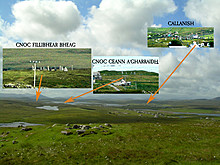|
|
|
|
Airigh Na Beinne BigeStone Circle
|
||||||||||||||||||||||||
|
|
|
News |
|
Lewis stone circle has star-shaped lightning strikeEvidence of a "massive" lightning strike has been found at the centre of a stone circle in the Western Isles. A single large strike, or many smaller ones on the same spot, left a star-shaped magnetic anomaly at the 4,000-year-old site in Lewis... continues... |
 Posted by moss
Posted by moss24th December 2019ce |
Images (click to view fullsize) |
|







|
Fieldnotes |
|
|
Visited 31.5.12 The remaining standing stone is approximately 1.5 metre tall x 0.5 metre across. The views from the stone are the best I have seen on Lewis – breathtaking. They show Lewis at its best – both rugged and beautiful. The sun darted in and out of clouds and lit up parts of the mountains in the distance. I was in the right place at the right time for the light to reveal ‘Sleeping Beauty’ in all her glory. She was so clear and recognisable – the best I had seen her during my stay - watching over all that she surveyed. The view set out in front of me had to be one of the highlights of my short but fulfilling stay on Lewis. Simply stunning. |
Posted by CARL 4th July 2012ce |
|
Visited 1st August 2004: When I set out to find Airigh Na Beinne Bige I got lead on a wild goose chase by the GPS, wondering around in totally the wrong area. The following directions might save you from the same fate: Follow the road inland from Breascleit until you come to a cattle grid. Immediately after the cattle grid park up (if you're driving) and walk up the hill (approximately north). You'll come to a 'peat covered terrace' below the summit of the hill. The remaining standing stone is relatively easy to spot, as is the larger of the two cairns. William and I found the big cairn first, then the standing stone and the hollow. Will found the remains of a dead sheep at the foot of the stone fascinating. The views of the Callanish area are spectacular! We had fun taking photos of each other with the digital camera. It was what people would have once described as 'a lark'. Unfortunately I only spoke to Margaret Curtis after this visit, and it was then that I came to fully appreciate that Airigh Na Beinne Bige is widely accepted as a ruined stone circle. If you can't speak to Margaret, read The Stones Around Callanish before you visit. |
 Posted by Kammer
Posted by Kammer9th February 2005ce Edited 9th February 2005ce |
Miscellaneous |
|
According to Historic Scotland this stone represents the remains of a stone circle. The record gives Margaret and Ron Curtis as one of it's sources:Survey work has established that the single standing stone, stone stumps, prostrate stones, other broken stones and packing stones at this site (DES 1976, 58) should be regarded as the remains of a stone circle. They mark the positions where eight standing stones once stood in a circle of about 51m diameter. The circle may have consisted of at least 13 standing stones. These eight positions are not continuous but extend along 7% and 39% of the perimeter.The area around the remaining standing stone is scheduled, and known to contain the remains of two burial cairns and a group of later shieling huts. Margaret Curtis (previously Ponting) has a stone axe that she found at the site (NB22233569) in 1976. There's an excellent plan of the ruined circle in the book The Stones Around Callanish by the Pontings (ISBN: 0 903960 67 2). |
 Posted by Kammer
Posted by Kammer6th December 2002ce Edited 26th January 2005ce |

